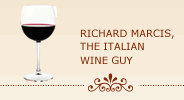Eight Great, Wallet-Friendly Super-Tuscans to Help Sooth the Winter of Our Discontent
Presented here are some great, wallet-friendly Super-Tuscan wines that while delicious in their own right may also help stave off the doldrums associated with reduced daylight hours and a too-long period of sheltering-in-place and social distancing while waiting anxiously for Covid-19 vaccinations.
“So, what is a Super-Tuscan and what’s so great about it?” you ask.
The term “Super-Tuscan” came into being in the late 1970’s – early 1980’s to describe a special group of wines that didn’t meet the regulatory requirements for any Tuscan DOC/DOCG label. The producers of these wines were mavericks that defied regional traditions and regulatory requirements and in so doing crafted some remarkable wines that caught the attention of the wine world and quickly gained recognition as some of Italy’s best.
The term “Super-Tuscan” is not an official designation so it doesn’t appear on wine bottle labels. Rather, it is an informal designation that includes a broad category of wines for which there are no hard and fast rules governing styles of wines or means of production. The producers are free to use any grape varieties and any winemaking or ageing protocols they choose. These wines are in effect proprietary wines created to reflect producers’ tastes and preferences for particular styles of wines.
Today, almost every Tuscan estate produces at least one Super-Tuscan wine and there is a formidable parade of Super-Tuscans on wine shop shelves. They can be expensive with some especially-sought-after Super-Tuscans bearing triple-digit price tags.
Fortunately for those that prefer not having to dig too deeply into their wallets in order to purchase an interesting wine, there are some reasonably-priced Super-Tuscans available. These are the ones that don’t get a lot of play in the popular press but are nonetheless well made and delicious and offer good value for the dollar.
Indicated below are eight inexpensive Super-Tuscan wines that rank high on a quality-to-price basis and are bargains by Super-Tuscan standards. But despite their modest prices, all the wines indicated below display character and complexity wrapped in a well-developed sense of style that rival some of the best features of more expensive and highly-touted wines.
Reflecting the flexibility and diversity inherent in the Super-Tuscan brand the wines can and do vary considerably in terms of structure and style. But each is in its own way a balm for the soul, a way to lift spirits as we hunker down for a dark winter.
The wines are listed below in alphabetical order by producer. All are generally available in major U.S. markets.
Tenuta di Biserno, “Insoglio del Cinghiale” Toscana IGT 2017 (about $23)
Tenuta di Biserno is 122-acre estate in the coastal Maremma area of western Tuscany that is a joint collaboration between the legendary winemakers Lodovico Antinori of Ornellaia and Masseto fame and his brother Piero Antinori of Tignanello fame.
 The 2017 “Insoglio del Cinghiale” is a blend of Syrah, Cabernet Franc and Merlot with a splash of Petit Verdot. Each variety is sourced from a different vineyard that has been identified as ideally suited for that specific variety. The grapes undergo a 2 to 3-week maceration on their skins in stainless steel tanks and the blended wine is aged for 4 months in used French oak barriques.
The 2017 “Insoglio del Cinghiale” is a blend of Syrah, Cabernet Franc and Merlot with a splash of Petit Verdot. Each variety is sourced from a different vineyard that has been identified as ideally suited for that specific variety. The grapes undergo a 2 to 3-week maceration on their skins in stainless steel tanks and the blended wine is aged for 4 months in used French oak barriques.
The result is a medium-weight wine with inviting, complex aromas, juicy dark fruit flavors and smooth tannins. It has 14 percent alcohol.
With its soft tannins, playful acidity and fruity aromas this wine offers plenty of drinking pleasure and is a flavorful companion for a wide range of dishes.
Grattamacco, Bolgheri Rosso 2018 (about $26)
Founded in 1977, Grattamacco was one of the first wineries in the Bolgheri area on Tuscany’s western coast. It has 35 acres of organically-farmed vineyards situated on a hilltop that favors the vineyards with less heat and humidity than those in the sea-coast-level Bolgheri zone.
Grattamacco Bolgheri Rosso is a Bordeaux-meets-Tuscany styled blend that consists of traditional Bordeaux varieties (Cabernet Sauvignon, Cabernet Franc, Merlot and Petit Verdot) with the addition of a small amount of Sangiovese. The grapes are fermented in stainless steel and the wine is aged in French oak barriques for 10 months with an additional 6 months in the bottle prior to release.
A gentle swishing of the wine glass releases a combo of black currant and prune aromas foretelling a rich and full-bodied wine. And the wine doesn’t disappoint – full-bodied, rich and juicy with ripe tannins and a touch of cassis that gives lift to the long finish. While its ready to drink now it has the stuffing to go the distance.
Guado al Tasso-Antinori, “Il Bruciato” 2018 (about $26)
Tenuta Guado al Tasso is the Bolgheri branch of Marchesi Antinori’s extensive Italian wine empire. The estate has 790 acres of vineyards in the prestigious Bolgheri DOC on the upper Maremma coast where it primarily grows traditional Bordeaux varieties as well as some Syrah. Reflecting this focus, the estate’s 2018 “Il Bruciato” is a blend of primarily Cabernet Sauvignon and Merlot with Syrah playing a supporting role.
The grapes are separately fermented on the skins in temperature-controlled stainless-steel tanks. Following fermentation, the wines are blended and then aged in French oak barriques for 7 months followed by 4 months in the bottle before release for sale.
The three varietals work seamlessly together with the Cabernet providing structure and body, the Merlot contributing a round, juicy mouthfeel and the Syrah adding its deep color and spicy, fruity overtones. The end result is a deeply colored, full-bodied, complex wine with intense dark fruit flavors and aromas. What’s not to like?
Il Borro, “Polissena” Toscana 2016 (about $34)
Il Borro is an ancient Tuscan castle with a long history of grape-growing but its modern wine-making story dates back to 1993 when the Ferragamo family, the high-end Italian shoe and leather goods retailer, purchased the property. In 1997 new grapevines were planted and it wasn’t until 2003 that the first Il Borro wines were marketed.
Il Borro produces primarily Toscana IGT wines made with international grape varieties such as Cabernet Sauvignon and Merlot in addition to Tuscany’s prized Sangiovese.
The 2016 Polissena is made entirely of Sangiovese. The grapes are fermented in stainless steel and the wine is aged for 12 months in previously-used French oak barriques and then spends an additional 6 months in the bottle prior to release.
The Polissena is medium-bodied with good acidity, plum and red raspberry flavors and sturdy tannins. This food-friendly offering pairs especially well with mushroom risotto, prosciutto and salami and any tomato-based dish.
Ornellaia, “Le Volte” Toscana Rosso 2018 (about $22)
The Tenuta dell’Ornellaia winery is one of the great and historic Super-Tuscan estates. Established in 1981 by Marchese Lodovico Antinori of the Antinori family it produces the highly-acclaimed Ornellaia, a Cabe rnet – Merlot blend that has been a collector’s favorite ever since its initial release in 1985 and comes with a triple-digit price tag.
rnet – Merlot blend that has been a collector’s favorite ever since its initial release in 1985 and comes with a triple-digit price tag.
Less expensive and certainly less famous but still complex and engaging is the estate’s “Le Volte.” It is made primarily of Merlot with small amounts of Cabernet Sauvignon and Sangiovese filling in the blend. This medium-weight, elegant wine has some of the best features of more expensive Merlot wines. It offers mature black fruit flavors with some spice notes, soft tannins and a gratifying finish.
The Le Volte offers the opportunity to sample the glory of an Ornellaia wine without having to pay a king’s ransom to do so.
Rocca di Frassinello, “Le Sughere di Frassinello” Maremma 2016 (about $26)
The Rocca di Frassinello winery is located in the central Maremma area between Bolgheri and Scansano on Tuscany’s western coast. The 225-acre vineyard operation is a joint Italian-French venture between the Castellare di Castellina winery in the heart of the Chianti Classico zone and Chateau Lafite Rothschild, one of France’s premier wine brands. Here they grow Tuscany’s main vine variety, Sangiovese, as well as France’s classic vines, Cabernet, Merlot, Petit Verdot and Syrah.
The 2016 Le Sughere di Frassinello (the wine takes its name from the cork trees - sughere in Italian - that line the vineyards) is a blend of 50 percent Sangiovese and 25 percent each Cabernet Sauvignon and Merlot. The grapes are fermented in temperature-controlled stainless steel and then aged for 12 months in a combination of new and used French oak barriques. The wine spends an additional 9 months in the bottle prior to release and has 14 percent alcohol.
With its expansive red-fruit bouquet and soft tannins this Italian-French blend makes for a delightful Super-Tuscan that would engage comfortably with either traditional Italian pasta dishes or classic French fare.
Tolaini, “Al Passo” Toscana IGT 2016 (about $24)
Tolaini’s “Al Passo” is a blend of almost equal parts Sangiovese, Cabernet Sauvignon and Merlot. The grapes undergo a relatively long 3-week fermentation on the skins in temperature-controlled steel tanks while a portion is fermented in French oak fermenters. After malolactic ferm entation the wine is aged in 20-percent new French oak barriques for 8 months and then bottled, unfiltered, where it rests for an additional year prior to release.
entation the wine is aged in 20-percent new French oak barriques for 8 months and then bottled, unfiltered, where it rests for an additional year prior to release.
Twenty-sixteen was a great year for Tuscan reds and the 2016 Al Passo doesn’t disappoint. It is medium-to-full bodied with good definition and structure. It has a juicy core of dark cherry and plum flavors supported by Sangiovese’s signature acidity overlaid with a touch of oak that follows through on the lengthy finish. The wine should continue to evolve and mature over the next several years.
The wine does throw some sediment so it’s best to decant before serving.
Tua Rita, “Rosso dei Notri” Toscana 2017 (about $18)
Tua Rita is a family-run winery located in Suvereto, a small hill-top town in the province of Livorno on the Tuscan coast south of Bolgheri. Founded in 1984, Tua Rita is most well-known for its highly-acclaimed “Redigaffi, a 100 percent Merlot wine that has achieved near cult status since its initial release in 1994.
The 2017 Rosso dei Notri is 50 percent Sangiovese with the remaining 50 percent a combination of Cabernet Sauvignon, Merlot and Petit Verdot. The wine is aged for a short period in a combination of French oak barriques and stainless-steel vats in order to maintain the freshness of the fruit. It spends 6 additional months in the bottle prior to release.
There are no rough edges here, just a smooth drinking experience with plush tannins, appetizing acidity and an elegant finish accented with some red fruit notes. The Rosso dei Notri has a lot going for it and is hard to beat on a value-to-price basis.
©Richard Marcis
December 8, 2020
Return to Wine Reviews and Musings
Help keep this website ad-free and independent.
Consider making a contribution to support the work of WineWordsWisdom.com.



